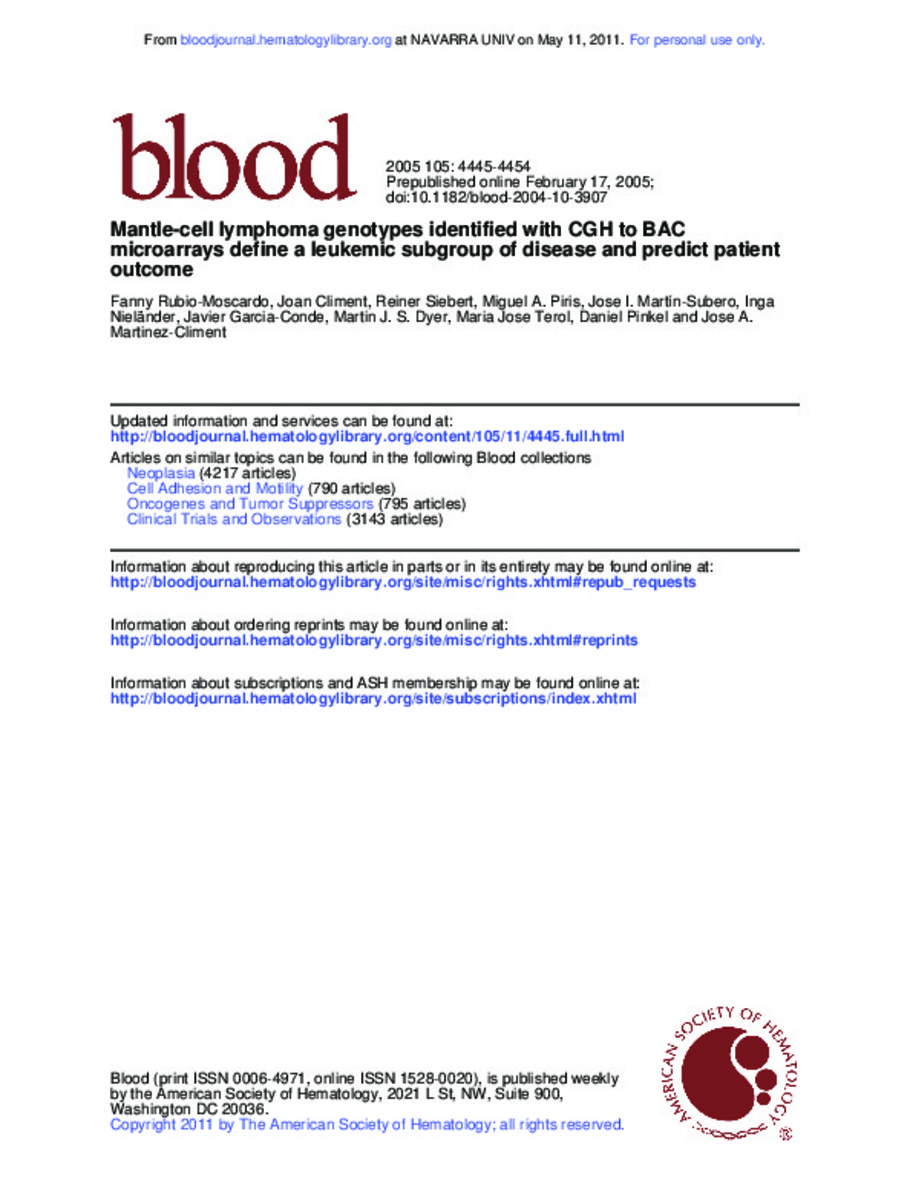Full metadata record
| DC Field | Value | Language |
|---|---|---|
| dc.creator | Rubio-Moscardo, F. (Fanny) | |
| dc.creator | Climent, J. (J.) | |
| dc.creator | Siebert, R. (Reiner) | |
| dc.creator | Piris, M.A. (Miguel A.) | |
| dc.creator | Martin-Subero, J.I. (Jose Ignacio) | |
| dc.creator | Nieländer, I. (Inga) | |
| dc.creator | Garcia-Conde, J. (J.) | |
| dc.creator | Dyer, M.J.S. (Martin J. S.) | |
| dc.creator | Terol, M.J. (María José) | |
| dc.creator | Pinkel, D. (Daniel) | |
| dc.creator | Martinez-Climent, J.A. (José Ángel) | |
| dc.date.accessioned | 2011-05-09T12:11:16Z | - |
| dc.date.available | 2011-05-09T12:11:16Z | - |
| dc.date.issued | 2005 | - |
| dc.identifier.citation | Rubio-Moscardo F, Climent J, Siebert R, Piris MA, Martin-Subero JI, Nielander I, et al. Mantle-cell lymphoma genotypes identified with CGH to BAC microarrays define a leukemic subgroup of disease and predict patient outcome. Blood 2005 Jun 1;105(11):4445-4454. | es_ES |
| dc.identifier.issn | 1528-0020 | - |
| dc.identifier.uri | https://hdl.handle.net/10171/17902 | - |
| dc.description.abstract | To identify recurrent genomic changes in mantle cell lymphoma (MCL), we used high-resolution comparative genomic hybridization (CGH) to bacterial artificial chromosome (BAC) microarrays in 68 patients and 9 MCL-derived cell lines. Array CGH defined an MCL genomic signature distinct from other B-cell lymphomas, including deletions of 1p21 and 11q22.3-ATM gene with coincident 10p12-BMI1 gene amplification and 10p14 deletion, along with a previously unidentified loss within 9q21-q22. Specific genomic alterations were associated with different subgroups of disease. Notably, 11 patients with leukemic MCL showed a different genomic profile than nodal cases, including 8p21.3 deletion at tumor necrosis factor-related apoptosis-inducing ligand (TRAIL) receptor gene cluster (55% versus 19%; P = .01) and gain of 8q24.1 at MYC locus (46% versus 14%; P = .015). Additionally, leukemic MCL exhibited frequent IGVH mutation (64% versus 21%; P = .009) with preferential VH4-39 use (36% versus 4%; P = .005) and followed a more indolent clinical course. Blastoid variants, increased number of genomic gains, and deletions of P16/INK4a and TP53 genes correlated with poorer outcomes, while 1p21 loss was associated with prolonged survival (P = .02). In multivariate analysis, deletion of 9q21-q22 was the strongest predictor for inferior survival (hazard ratio [HR], 6; confidence interval [CI], 2.3 to 15.7). Our study highlights the genomic profile as a predictor for clinical outcome and suggests that "genome scanning" of chromosomes 1p21, 9q21-q22, 9p21.3-P16/INK4a, and 17p13.1-TP53 may be clinically useful in MCL. | es_ES |
| dc.language.iso | eng | es_ES |
| dc.publisher | American Society of Hematology | es_ES |
| dc.rights | info:eu-repo/semantics/openAccess | es_ES |
| dc.subject | Lymphoma, Mantle-Cell | es_ES |
| dc.subject | Gene expression profiling | es_ES |
| dc.title | Mantle-cell lymphoma genotypes identified with CGH to BAC microarrays define a leukemic subgroup of disease and predict patient outcome | es_ES |
| dc.type | info:eu-repo/semantics/article | es_ES |
| dc.relation.publisherversion | http://bloodjournal.hematologylibrary.org/content/105/11/4445.long | es_ES |
Files in This Item:
Statistics and impact
Items in Dadun are protected by copyright, with all rights reserved, unless otherwise indicated.






